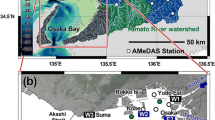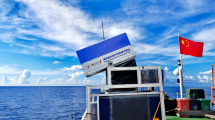Abstract
To trace offshore surface low-salinity water (LSW) in the northeastern Gulf of Mexico, a proxy was developed using the surface water beam attenuation coefficient (c p), and salinity matched with synchronous Sea-viewing Wide Field-of-view Sensor (SeaWiFS) satellite data from three annual summer cruises (July 1998–August 2000) using a two-step empirical approach. First, a relationship between in-situ salinity and c p was obtained. Second, in-situ c p was matched with SeaWiFS radiance ratios of all available blue-to-green wavelengths. Finally, satellite-derived surface salinity was determined directly by combining the two empirical relationships, providing a robust estimate over a range of salinities (26–36). This significantly improves the limited spatial and temporal resolution of surface salinity distribution obtained by shipboard sampling. The resulting correlation is best explained as mixing between low-salinity plume waters and normal salinity Gulf waters. The empirical relationships were used to map satellite-derived salinity using the average of SeaWiFS images during each summer cruise. As expected for summer, spatial patterns of LSW plumes with high c p, particulate matter (PM), particulate organic carbon (POC), and chlorophyll-a (Chl-a) were connected to the mouth of the Mississippi River Delta and extended to the east-southeast. Normal salinity Gulf water with lower c p, PM, POC, and Chl-a was confined to the shelf and upper slope in the eastern part of the study area, outside the plumes. This proxy approach can be applied throughout the region of shipboard sampling for more detailed coverage and analysis.










Similar content being viewed by others
References
Ahn YH, Shanmugam P, Rhy JH, Jeong JC (2006) Satellite detection of harmful algal bloom occurrences in Korean waters. Harmful Algae 5:213–231
Ahn YH, Shanmugam P, Moon JE, Ryu JH (2008) Satellite remote sensing of a low-salinity plume in the East China Sea. Ann Geophys 26:2019–2035
Bailey SW, Werdell PJ (2006) A multi-sensor approach for the on-orbit validation of ocean color satellite data products. Remote Sens Environ 102:12–23
Baker ET, Lavelle JW (1984) The effect of particle size on the light attenuation coefficient of natural suspensions. J Geophys Res 89:8197–8203
Bernal CE (2001) Spatial and temporal distributions of particulate matter and particulate organic carbon, northeast Gulf of Mexico. MS thesis, Texas A&M University, College Station
Biggs DC (1992) Nutrients, plankton, and productivity in a warm-core ring in the western Gulf of Mexico. J Geophys Res 97:2143–2154
Biggs DC, Muller-Karger FE (1994) Ship and satellite observation of chlorophyll stocks in interesting cyclone–anticyclone eddy pairs in the western Gulf of Mexico. J Geophys Res 99(4):7371–7384
Binding CE, Bowers DG (2003) Measuring the salinity of the Clyde Sea from remotely sensed ocean color. Estuar Coast Shelf Sci 57:605–611
Bishop JKB (1999) Transmissometer measurement of POC. Deep Sea Res I 46(2):353–369
Boesch DF, Boynton WR, Crowder LB, Diaz RJ, Howarth RW, Mee LD, Nixon SW, Rabalais NN, Rosenberg R, Sanders JG, Scavia D, Tuner RE (2009) Nutrient enrichment drives Gulf of Mexico hypoxia. EOS 90:117–118
Bricaud A, Morel A, Prieur L (1981) Absorption by dissolved organic matter of the sea (yellow substance) in the UV and visible domains. Limnol Oceanogr 26(1):43–53
Brooks DA, Legeckis RV (1982) A ship and satellite view of hydrographic features in the western Gulf of Mexico. J Geophys Res 87:4195–4206
Carder KL, Chen FR, Lee ZP, Hawes SK, Kamykowski D (1999) Semianalytic Moderate-Resolution Imaging Spectrometer algorithms for chlorophyll-a and absorption with bio-optical domains based on nitrate-depletion temperatures. J Geophys Res 104:5403–5421
Chung SP, Gardner WD, Landry MR, Richardson MJ, Walsh ID (1998) Beam attenuation by microorganism and detrital particles in the equatorial Pacific. J Geophys Res 103:12669–12681
D’Sa EJ, DiMarco SF (2009) Seasonal variability and controls on chromophoric dissolved organic matter in large river-dominated coastal margin. Limnol Oceanogr 54(6):2233–2242
D’Sa EJ, Miller RL (2003) Bio-optical properties in waters influenced by the Mississippi River during low flow conditions. Remote Sens Environ 84:538–549
Gardner WD, Walsh ID, Richardson MJ (1993) Biophysical forcing of particle production and distribution during a spring bloom in the North Atlantic. Deep Sea Res II 40:171–195
Gardner WD, Mishonov AV, Richardson MJ (2006) Global POC concentrations from in situ and satellite data. Deep Sea Res II 53:718–740
Gilbes F, Thomas C, Walsh JJ, Muller-Karger FE (1996) An episodic chlorophyll plume on the West Florida Shelf. Cont Shelf Res 16:1201–1224
Gilbes F, Muller-Karger FE, DelCastillo C (2002) New evidence for the West Florida Shelf Plume. Cont Shelf Res 22:2479–2496
Gordon HR, Wang M (1994) Retrieval of water-leaving radiance and aerosol optical thickness over the oceans with SeaWiFS: a preliminary algorithm. Appl Opt 33:443–452
Green RE, Gould RW Jr, Ko DS (2008) Statistical models for sediment/detritus and dissolved absorption coefficients in coastal waters of the northern Gulf of Mexico. Cont Shelf Res 28:1273–1285
Hamilton P, Fargion GS, Biggs DV (1999) Loop current eddy paths in the western Gulf of Mexico. J Phys Oceanogr 29:1180–1207
Hamilton P, Berger TJ, Johnson W (2002) On the structure and motions of cyclones in the northern Gulf of Mexico. J Geophys Res 107:3208–3226
Hooker SB, Firestone ER, Acker JC (1994) SeaWiFS pre-launch radiometric calibration and spectral characterization. SeaWiFS technical report series, NASA Technical Memorandum 104566, vol 23
Hu C, Muller-Karger FE, Biggs DC, Carder KL, Nababan B, Nadeau D, Vanderbloemen J (2003) Comparison of ship and satellite bio-optical measurements on the continental margin of the NE Gulf of Mexico. Int J Remote Sens 24(13):2597–2612
Hu C, Chen Z, Clayton TD, Swarzenski P, Brock JC, Muller-Karger FE (2004) Assessment of estuarine water-quality indicators using MODIS medium-resolution bands: initial results from Tampa Bay, FL. Remote Sens Environ 93:423–441
Kim H-C, Yamaguchi H, Yoo SJ, Zhu J, Okamura K, Kiyomoto Y, Tanaka K, Kim S-W, Park TW, Oh IS, Ishizaka J (2009) Distribution of Changjiang diluted water detected by satellite chlorophyll-a and its interannual variation during 1998–2007. J Oceanogr 65:129–135
McClain CR, Feldman GC, Hooker SB (2004) An overview of the SeaWiFS project and strategies for producing a climate research quality global ocean bio-optical time series. Deep Sea Res II 51:5–42
Mishonov AV, Gardner WD, Richardson MJ (2003) Remote sensing and surface POC concentration in the South Atlantic. Deep Sea Res II 50:2997–3015
Morey SL, Martin PJ, O’Brien JJ, Wallcraft AA, Zavala-Hidalgo J (2003) Export pathways for river discharged fresh water in the northern Gulf of Mexico. J Geophys Res 108(C10). doi:10.1029/20002JC001674
Nittrouer CA, Wright LD (1994) Transport of particles across continental shelves. Rev Geophys 32(1):85–113
Nowlin WD, Jochens AE, Reid RO, DiMarco SF (1998) Texas-Louisiana shelf circulation and transport processes study: synthesis report, vol I: technical report. OCS Study MMS 98-0035. U.S. Department of the Interior, Minerals Management Service, Gulf of Mexico, OCS Region, New Orleans, LA
Ohlmann JC, Niiler PP (2005) Circulation over the continental shelf in the northern Gulf of Mexico. Prog Oceanogr 64:45–81
Qian Y, Jochens AE, Kennicutt MCII, Biggs DC (2003) Spatial and temporal variability of phytoplankton biomass and community structure over the continental margin of the northeast Gulf of Mexico based on pigment analysis. Cont Shelf Res 23:1–17
Rabalais NN, Turner RE, Justic D, Dortch Q, Wiseman WJ, Sen Gupta BK (1996) Nutrient changes in the Mississippi River and system responses on the adjacent continental shelf. Estuaries 19:386–407
Roesler CS, Boss E (2003) Spectral beam attenuation coefficient retrieved from ocean color inversion. Geophys Res Lett 30:1468. doi:10.1029/2002GL016185
Ross CB, Gardner WD, Richardson MJ, Asper VL (2009) Currents and sediment transport in the Mississippi Canyon and effects of Hurricane Georges. Cont Shelf Res 29:1384–1396
Sahl LE, Wiesenburg DA, Merrell WJ (1997) Interactions of mesoscale features with Texas shelf and slope waters. Cont Shelf Res 17:117–136
Sasaki H, Siswanto E, Nishiuchi K, Tanaka K, Hasegawa T, Ishizaka J (2008) Mapping the low salinity Changjiang diluted water using satellite retrieved colored dissolved organic matter (CDOM) in the East China Sea during high river flow season. Geophys Res Lett 35:L04604. doi:10.1029/2007GL032637
Schiller RV, Kourafalou VH, Hogan P, Walker ND (2011) The dynamics of the Mississippi River plume: impact of topography, wind and offshore forcing on the fate of plume waters. J Geophys Res 116:C06029. doi:10.1029/2010JC006883
Siegel DA, Maritorena S, Nel NB, Behrenfeld MJ (2005) Independence and interdependencies among global ocean color properties: reassessing the bio-optical assumption. J Geophys Res 110:C07011. doi:10.1029/2004JC002527
Son YB (2006) POC algorithms based on spectral remote sensing data and its temporal and spatial variability in the Gulf of Mexico. PhD thesis, Texas A&M University, College Station
Son YB, Gardner WD (2010) Determining spatial and temporal variations of surface particulate organic carbon (POC) using in-situ measurements and remote sensing data in the northeastern Gulf of Mexico during El Niño and La Niña. The Sea J Korean Soc Oceanogr 15(2):51–61 (in Korean with English abstract)
Son YB, Gardner WD (2011) Climatological variability of surface particulate organic carbon (POC) and physical processes based on ocean color data in the Gulf of Mexico. Korean J Remote Sens 27(3):235–258
Son YB, Gardner WD, Mishonov AV, Richardson MJ (2009a) Model-based remote sensing algorithms for particulate organic carbon (POC) in the northeastern Gulf of Mexico. J Earth Syst Sci 1:1–10
Son YB, Gardner WD, Mishonov AV, Richardson MJ (2009b) Multispectral remote-sensing algorithms for particulate organic carbon (POC): the Gulf of Mexico. Remote Sens Environ 113:50–61
Son YB, Ishizaka J, Jeong J-C, Kim H-C, Lee T (2011) Cochlodinium polykrikoides red tide detection in the South Sea of Korea using spectral classification of MODIS data. Ocean Sci J 46(4):239–263
Stramski D, Reynolds RA, Babin M, Kaczmarek S, Lewis MR, Rottgers R, Sciandra A, Stramska M, Twardowski MS, Franz BA, Claustre H (2008) Relationship between the surface concentration of particulate organic carbon and optical properties in the eastern South Pacific and eastern Atlantic Oceans. Biogeosciences 5:171–201
Sydor M, Arnone RA (1997) Effect of suspended particles and dissolved organic matter on remote sensing of coastal and riverine waters. Appl Opt 36:6905–6912
Walker ND (1996) Satellite assessment of Mississippi River plume variability: causes and predictability. Remote Sens Environ 58:21–35
Walker ND, Rouse LJ, Rouge B, Fargion GS, Biggs DC (1994) The great flood of summer 1993: Mississippi River discharge studied. EOS 75:409
Walker ND, Wiseman WJJR, Rouse LJJR, Babin A (2005) Effects of river discharge, wind stress, and slope eddies on circulation and the satellite-observed structure of the Mississippi River Plume. J Coast Res 21(6):1228–1244
Wentz FJ, LeVine D (2008) Algorithm theoretical basis document Aquarius level-2 radiometer algorithm: revision 1. Aquarius RSS Technical Report 012208, Aquarius Ground Segment, Goddard Space Flight Center, January 2008
Acknowledgments
The work of scientists and technicians who participated in the Minerals Management Service-funded NEGOM program (OCS Study 98-0060) is greatly appreciated. This study was a part of the project entitled “Support for research and applications of Geostationary Ocean Color Imager (GOCI)” and “Assessment of the Impact of Climate change on Marine Ecosystem in the South Sea of Korea” funded by the Ministry of Land, Transport, and Maritime Affairs, Korea, and partially financially supported by KORDI projects (KORDI contract numbers PE98781) and Hansung University. SeaWiFS data are the property of the GeoEye Corporation, and their use here is in accordance with the SeaWiFS Research Data Use Terms and Conditions Agreement of the NASA SeaWiFS project and is gratefully acknowledged.
Author information
Authors and Affiliations
Corresponding author
Rights and permissions
About this article
Cite this article
Son, Y.B., Gardner, W.D., Richardson, M.J. et al. Tracing offshore low-salinity plumes in the Northeastern Gulf of Mexico during the summer season by use of multispectral remote-sensing data. J Oceanogr 68, 743–760 (2012). https://doi.org/10.1007/s10872-012-0131-y
Received:
Revised:
Accepted:
Published:
Issue Date:
DOI: https://doi.org/10.1007/s10872-012-0131-y




